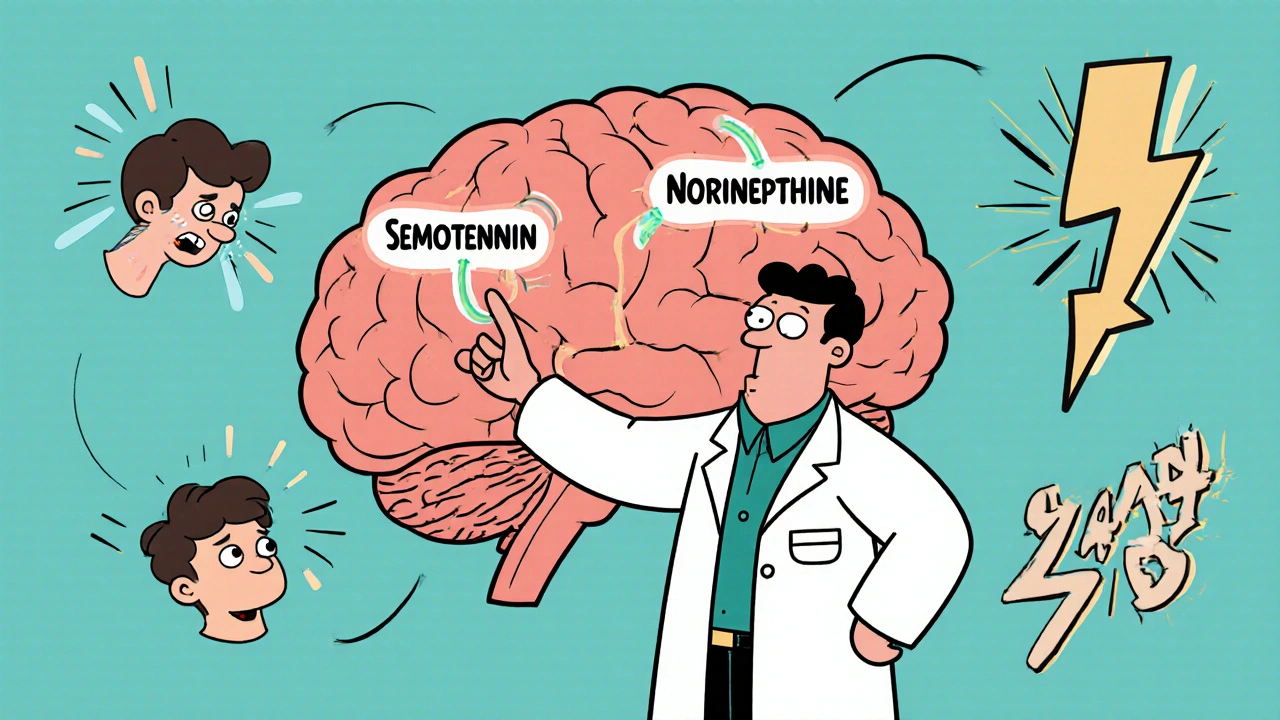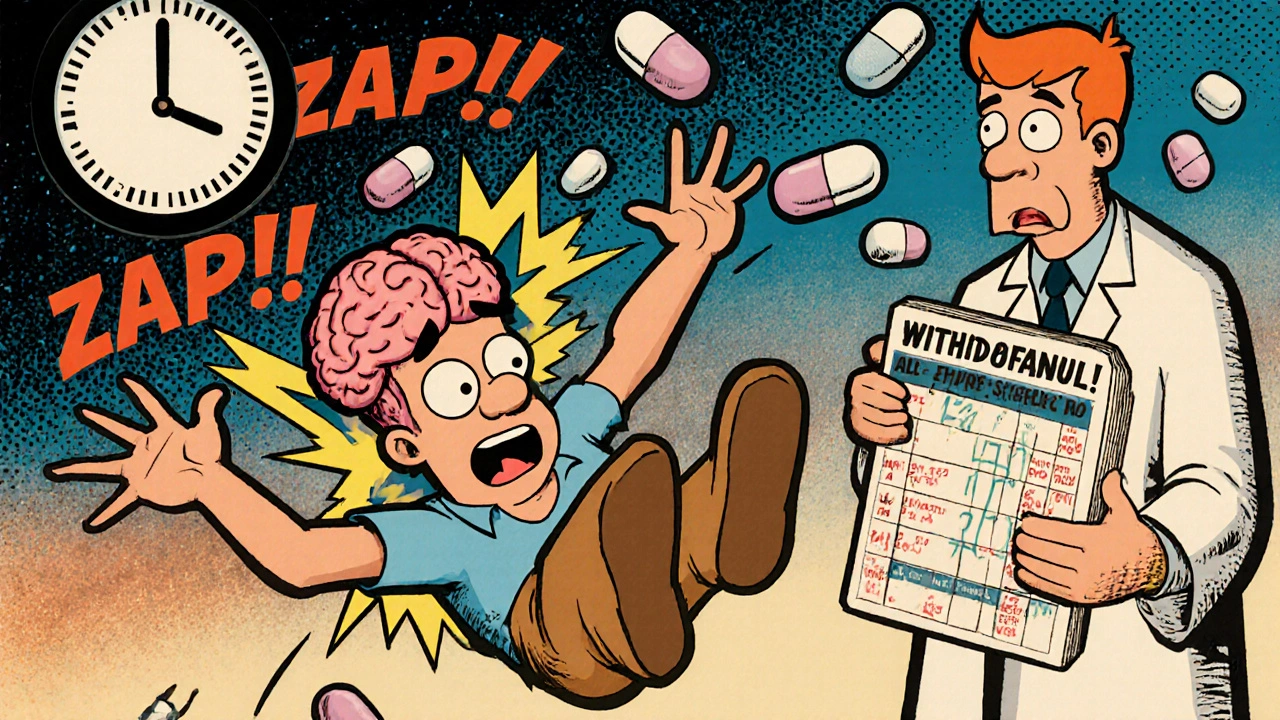SNRI Medication Comparison Tool
Compare SNRI Medications
This tool helps you understand key differences between common SNRI medications. Select a medication below to see its unique characteristics, approved uses, and potential side effects.
When you're struggling with depression and chronic pain at the same time, finding a medication that helps both can feel like a breakthrough. That’s where SNRI medications come in. Unlike older antidepressants that only target serotonin, SNRIs-serotonin-norepinephrine reuptake inhibitors-work on two key brain chemicals at once. This dual action makes them uniquely useful for people who not only feel down but also carry the heavy weight of ongoing physical pain. But they’re not without trade-offs. Side effects like nausea, high blood pressure, and intense withdrawal symptoms are real, and knowing what to expect can make all the difference.
How SNRIs Actually Work
SNRIs stop your brain from reabsorbing serotonin and norepinephrine too quickly. These two chemicals help regulate mood, energy, focus, and even how your body processes pain. When they’re in short supply, you might feel lethargic, hopeless, or overly sensitive to discomfort. By keeping more of these neurotransmitters active in your brain, SNRIs help smooth out those rough edges.
It’s not just about lifting your mood. Norepinephrine also plays a big role in how your nervous system handles pain signals. That’s why drugs like duloxetine and venlafaxine are approved not just for depression, but also for fibromyalgia, diabetic nerve pain, and chronic back pain. This dual benefit is why many doctors reach for SNRIs when SSRIs alone don’t cut it.
Not all SNRIs are the same. Venlafaxine has a much stronger effect on serotonin than norepinephrine-about 30 times stronger-at lower doses. But as the dose goes up, it starts blocking norepinephrine reuptake too. Duloxetine and desvenlafaxine are more balanced, with a slight edge toward serotonin. Levomilnacipran and milnacipran, on the other hand, are more focused on norepinephrine, which might make them better for pain but also raise the risk of side effects like increased heart rate and blood pressure.
Common SNRIs and Their Uses
The FDA has approved five main SNRIs for use in the U.S.:
- Venlafaxine (Effexor XR): First approved in 1993, it’s one of the most prescribed SNRIs. Used for depression, generalized anxiety, social anxiety, and panic disorder. Available as a once-daily extended-release tablet.
- Duloxetine (Cymbalta, Drizalma Sprinkle): Approved in 2004, it’s the only SNRI with FDA approval for five conditions: major depression, generalized anxiety, diabetic nerve pain, fibromyalgia, and chronic musculoskeletal pain. Often chosen when pain and mood issues overlap.
- Desvenlafaxine (Pristiq): The active metabolite of venlafaxine. Approved in 2008. Similar effectiveness, but marketed as having fewer drug interactions.
- Levomilnacipran (Fetzima): Approved in 2013. More selective for norepinephrine, which may help with fatigue and low energy in depression.
- Milnacipran (Savella): Approved in 2009 specifically for fibromyalgia. Not approved for depression in the U.S., though it’s used for that elsewhere.
Generic versions of venlafaxine and desvenlafaxine are widely available and cost as little as $4-$8 per month. Duloxetine generics are also common, though brand-name Cymbalta still accounts for over $1 billion in annual U.S. sales-proof that many patients continue to benefit despite the availability of cheaper options.
Side Effects: What to Expect
Most people experience at least one side effect when starting an SNRI. The good news? Many fade after a few weeks. The bad news? Some stick around-or get worse.
Common side effects:
- Nausea: Affects 25-30% of users, especially with duloxetine. Often improves within 2-4 weeks. Taking the pill with food helps.
- Sexual dysfunction: Reported by 20-40% of users. Includes low libido, delayed orgasm, or inability to climax. In patient reviews, up to 65% cite this as a major concern.
- Dizziness and lightheadedness: Especially common in the first week. Can be worsened by standing up too fast.
- Increased sweating: Seen in about 20% of duloxetine users.
- Constipation and dry mouth: Less common than with older antidepressants, but still occur in 15% and 30% of users, respectively.
More serious risks:
- High blood pressure: Especially with venlafaxine at doses above 150 mg/day. About 12-15% of patients develop hypertension. Regular blood pressure checks are recommended.
- Serotonin syndrome: A rare but dangerous reaction that can occur if you mix SNRIs with other serotonergic drugs like tramadol, triptans, or MAOIs. Symptoms include confusion, rapid heart rate, high fever, muscle stiffness, and seizures. Requires emergency care.
- Bleeding risk: SNRIs reduce serotonin in platelets, which can make you bruise or bleed more easily. This matters if you’re on blood thinners or planning surgery.
- Weight changes: Some users lose a few pounds early on (especially with duloxetine), but many gain weight over time. Long-term use can lead to a 5-10 pound increase.

The Withdrawal Problem
If you stop an SNRI cold turkey, you’re likely to feel awful. Between 40% and 50% of people experience withdrawal symptoms-sometimes called “discontinuation syndrome.” These aren’t signs of addiction, but rather your brain adjusting after being used to higher levels of serotonin and norepinephrine.
Symptoms include:
- Dizziness or vertigo
- Electric-shock sensations in the head (“brain zaps”)
- Flu-like fatigue
- Insomnia or vivid dreams
- Nausea and vomiting
- Increased anxiety or irritability
Patients on venlafaxine report this more than others. In fact, 54% of users on Reddit describe the “venlafaxine cliff”-a sudden crash if they miss even one dose. That’s why doctors recommend tapering slowly over 2-4 weeks. About 78% of prescribers follow this guideline, according to a 2022 JAMA survey.
SNRIs vs. Other Antidepressants
How do SNRIs stack up against the competition?
- SSRIs (like sertraline or fluoxetine) only affect serotonin. They’re often first-line because they’re gentler, but they don’t help much with physical pain. If you’ve tried an SSRI and still feel tired or achy, an SNRI might be the next step.
- TCAs (like amitriptyline) also affect serotonin and norepinephrine-but they hit a dozen other receptors, causing dry mouth, constipation, drowsiness, and heart rhythm problems. SNRIs are much cleaner and safer, especially for older adults.
- MAOIs are effective but require strict diets and carry serious interaction risks. They’re rarely used today unless everything else has failed.
SNRIs aren’t perfect, but they fill a real gap: helping people who need both emotional and physical relief. For someone with depression and fibromyalgia, duloxetine might be the only medication that truly improves both.
What the Research Says
Studies show SNRIs are slightly more effective than SSRIs for treating severe depression, especially when fatigue and lack of motivation are prominent. One meta-analysis found that venlafaxine had a 10-15% higher response rate than SSRIs in patients with high levels of physical symptoms.
But the science isn’t simple. The idea that depression is just a “chemical imbalance” is outdated. SNRIs likely work partly by reducing inflammation in the brain. New research suggests they calm overactive immune cells called microglia, which may be driving some depression symptoms. That’s why they’re being studied for PTSD, ADHD, and even menopausal mood swings.
Still, not everyone responds. About 30-40% of people don’t get full relief from SNRIs. That’s why doctors often try one, wait 6-8 weeks, and then switch if needed.

Practical Tips for Starting an SNRI
If your doctor prescribes an SNRI, here’s what to do:
- Start low: Venlafaxine usually begins at 37.5 mg/day; duloxetine at 30 mg/day. This reduces nausea and dizziness.
- Take with food: Especially important for duloxetine to avoid stomach upset.
- Monitor your blood pressure: If you’re on venlafaxine over 150 mg/day, check it weekly for the first month.
- Don’t stop suddenly: Even if you feel better, taper slowly. Ask your doctor for a schedule.
- Watch for warning signs: If you feel unusually agitated, have racing thoughts, or develop muscle stiffness, call your doctor immediately-this could be serotonin syndrome.
- Be patient: It takes 4-6 weeks to feel the full effect. Don’t give up too soon.
Many people report feeling more energy and clarity after a few weeks-something SSRIs often don’t provide. But the trade-off is that the side effects can be tougher to manage at first.
What Patients Are Saying
Real-world feedback paints a mixed picture:
- On Drugs.com, 72% of venlafaxine users say their mood improved significantly. But 68% also say withdrawal was brutal.
- For duloxetine, 45% report nausea at first, but 80% say it faded after a month. Many praise its pain relief-especially for back and nerve pain.
- Sexual side effects are the #1 complaint across all SNRIs. Some users say they’d rather live with low mood than lose their sex drive.
- One user wrote: “Duloxetine lifted my depression and made my arthritis bearable. But I gained 12 pounds and couldn’t have an orgasm for six months. Was it worth it? I don’t know.”
There’s no one-size-fits-all answer. What works for one person might not work for another. The key is tracking your own response and communicating openly with your provider.
What’s Next for SNRIs?
The SNRI market is growing. Global sales hit $4.6 billion in 2022, and prescriptions are expected to rise 5% annually through 2027. Why? Because more people are living with both depression and chronic pain-especially as the population ages.
New drugs are in development. LY03015, a novel SNRI with a more balanced serotonin-norepinephrine profile, is in Phase III trials. The goal? Better efficacy with fewer side effects.
Meanwhile, researchers are exploring SNRIs for conditions like ADHD and PTSD. Early results are promising, but nothing’s approved yet.
For now, venlafaxine and duloxetine remain the workhorses. They’re not perfect, but for millions of people, they’re the difference between barely getting by and actually living.
Do SNRIs cause weight gain?
Some people lose a few pounds in the first few weeks, especially with duloxetine. But over time, many gain weight-often 5-10 pounds or more. This isn’t universal, but it’s common enough that doctors monitor it. Weight gain may be due to improved appetite as depression lifts, or changes in metabolism. Switching medications or adding lifestyle changes can help.
Can I drink alcohol while taking SNRIs?
It’s not recommended. Alcohol can worsen dizziness, drowsiness, and depression symptoms. It also increases the risk of liver damage and can raise blood pressure-especially with venlafaxine. Even moderate drinking can interfere with how well the medication works. If you drink, talk to your doctor about safe limits.
How long until SNRIs start working?
Most people notice small improvements in energy or sleep within 1-2 weeks. But full mood and pain relief usually takes 4-8 weeks. Don’t stop just because you don’t feel better right away. If there’s no change after 8 weeks, talk to your doctor about adjusting the dose or switching meds.
Are SNRIs addictive?
No, SNRIs are not addictive in the way opioids or benzodiazepines are. You won’t crave them or need more to get the same effect. But your body does adapt to them. Stopping suddenly can cause withdrawal symptoms, which is why tapering is essential. This is a physical adjustment, not addiction.
Can SNRIs help with anxiety?
Yes. Venlafaxine and duloxetine are FDA-approved for generalized anxiety disorder, social anxiety, and panic disorder. Many patients find them more effective for anxiety than SSRIs, especially when anxiety comes with physical tension, racing heart, or restlessness. The norepinephrine boost helps calm the body’s stress response.
What’s the difference between venlafaxine and duloxetine?
Venlafaxine is better for mood and anxiety disorders, while duloxetine is stronger for pain. Venlafaxine has a higher risk of blood pressure spikes at high doses. Duloxetine causes more nausea at first but is easier to taper. Venlafaxine is available in cheaper generics. Duloxetine has more FDA approvals for pain conditions. Your doctor will choose based on your main symptoms.



Patrick Klepek
October 31, 2025 AT 23:39Caden Little
November 2, 2025 AT 05:13Michael Schaller
November 3, 2025 AT 09:31Kyle Tampier
November 4, 2025 AT 20:53Michael Ferguson
November 4, 2025 AT 21:53Sebastian Brice
November 5, 2025 AT 18:11Jim Aondongu
November 7, 2025 AT 13:07Tom Caruana
November 9, 2025 AT 07:54Muzzafar Magray
November 10, 2025 AT 23:10